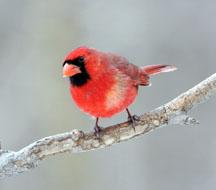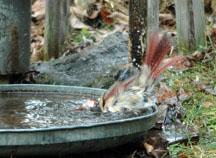The fight of a Northern Cardinal
- Share
- Tweet
- Pin
- Share
Our lone resident male Cardinal had a “feather raising” encounter recently that came within inches of claiming his life.
I had just returned from the village and driven onto the turn-around in front of our house when I noticed what appeared to be a small spread-out piece of red cloth lying on the ground with another bird on top of it. The second I hurriedly got out of the car, away flew a Sharp-shinned Hawk that had caught our male Cardinal, forced it to the ground and was about to kill it.
The Cardinal struggled to his feet, walked beneath the nearby wildflower leaves next to the driveway and disappeared. I could not locate the bird which appeared to be badly injured. Later that day, while we were eating and watching the front yard feeders, the male Cardinal’s mate came by herself several times for sunflower seeds at the feeders. Nearly always in recent weeks the pair had been feeding together. When there was no sign of the male the following day we naturally began thinking that the male had died from his injuries.
You can imagine our joy the third day when the pair arrived to feed together, he showing several areas on his side, chest and back where feathers had been torn out by the hawk. He was a mess, but obviously was a real fighter and had survived the attack. Earlier in the year we noticed he had a noticeably damaged area on the left side of his chest, lighter in color than the surrounding red plumage, where apparently feathers had been torn out during a previous encounter. What a courageous fighter of a mate that lady redbird has!
As much as we try to not single out favorite birds, those that are year-around visitors to our feeders and that nest and raise their young in our woods rank near the top. Before moving into our home in the center of the county in the fall of 1982, we lived in the Upper Rangelight Residence at the Ridges Sanctuary in Baileys Harbor, me for 16 years, Charlotte for 10. Northern Cardinals were common and downright abundant during most of those years with as many as 20 being counted at one instant at dusk feeding on sunflower seeds in the backyard during the coldest of winter days.
Coming to live in a considerably different mixed hardwood environment, we went without having nesting Cardinals on our land for the next 26 years. Finally, in June of 2009, a Cardinal pair brought their young to the feeders giving us good reason to celebrate!
The arrival of the first Cardinals in Wisconsin in the very early 1900s and their steady movement northward in the state has been widely documented by Breeding Bird Surveys, Christmas Bird Counts and personal observations. Dr. Stanley Temple, bird specialist at the UW-Madison for many years, included the following in his summary of the Northern Cardinal in the excellent Atlas of the Breeding Birds of Wisconsin, published in 2006: “Moderate winter temperatures and less snow cover, new edge habitats and second growth created by human activities, and winter food resources provided by agriculture and winter bird feeding all seem to have played a role in allowing this southern species to become a common permanent resident in the southern two-thirds of Wisconsin (Halkin and Linville 1999).”
Happily, many people in Door County report having Cardinals coming to their feeders, a welcome species that has become very well established in this region. I recall well my first sighting of a male Cardinal. It was during my army days in the early spring of 1954 at Ft. Sill, OK. We had arrived around sun-up at a rendezvous point and found ourselves with an hour of free time as we waited for the crew moving the monstrous atomic cannons to catch up with us. The morning was warm and pleasant and the quiet woods inviting, so I grabbed a pair of binoculars from the supply box and set out to explore.
A shrill “CHEER, CHEER, CHEER” startled me, very humanlike, and immediately the challenge was on. What a beacon to zero in on – one could hardly miss. The song was one I had never heard before, and this added to the excitement. Suddenly there he was in all his scarlet finery and not in the least concerned with my presence.
It was not until the late 1950s that I saw my first Cardinal in my hometown of Kewaunee. About that time I discovered a small printed notice tucked into an old bird book I had purchased from Paul’s Used Bookstore when I was a student in grad school at UW-Madison. The notice was printed in about 1903 and sent to various birdwatchers throughout Wisconsin asking them to assist in a winter bird survey. Special mention was directed to those living in the southern part of the state to be especially on the watch for Cardinal Grosbeaks, (as they were referred to then), as a few had been seen near Lake Geneva immediately north of the Illinois state line.
Apparently their range was just beginning to include Wisconsin. According to old records, Cardinals were only casually seen north of the Ohio River Valley by 1886. Today they are common in southern Ontario. The dominant breeding birds in spring drive others to different areas. Then too, Cardinals are known to group together and do some wandering in winter. Undoubtedly people putting out food in winter (and year-around) for the birds encourages this species to remain and to raise young.
It is very common for Cardinals to have two broods each summer and we’re quite sure we observed a third brood during one of the years we lived at the Ridges. The male and female fledglings look alike, generally appear like the female but sport dark beaks. Gradually, by late fall, the young have molted and by winter have attained their first winter plumage and will look just like the adults. The soft olive-gray feather edges will have worn off by spring and the males will have arrived at their most aristocratic elegance, the reddest of the Cardinal reds.
The Cardinals at our place love to bathe, always in either of the two garbage can lids filled with water on the ground close to the nearby small cedar trees for instant protection. They are extremely reliable and doting parents, continue to be ultra cautious as Cardinals tend to be and will always rank among those wild birds that supply us with much beauty, song and fascinating observing throughout the year. They make for Red-Letter days!





